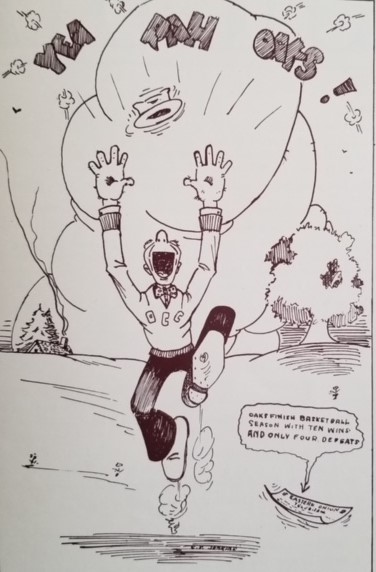In 1891, James Naismith was tasked by his employer at the Y.M.C.A. International Training School at Springfield, Massachusetts, to come up with an indoor team sport that could be played in the winter season. After several failed attempts to create a game young members found exciting, Naismith finally came up with the game of basketball, initially written as basket-ball because of the use of peach baskets for goals.
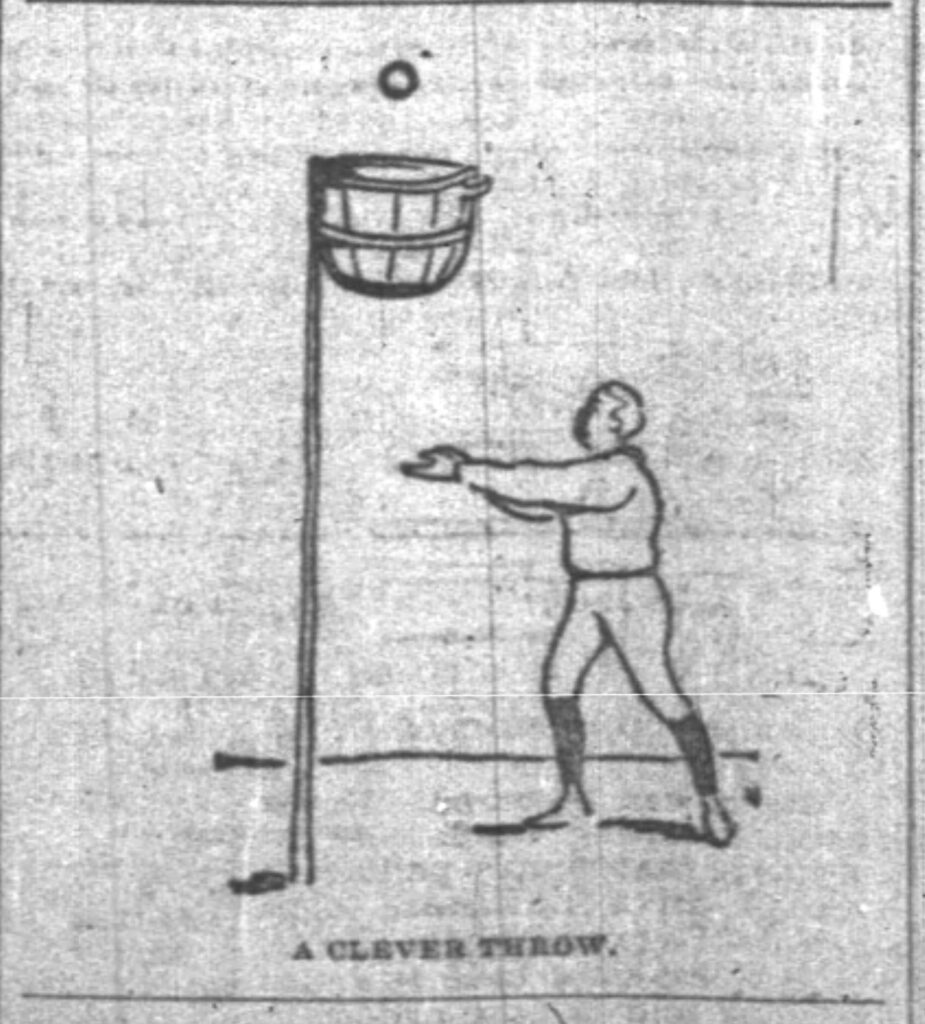
The Y.M.C.A. system would spread the new game of basketball throughout the nation, creating local and state leagues and providing both gymnasiums and instructions, the latter helping to keep the rules consistent wherever the game was played. Y.M.C.A. directors across the country soon realized they had a winner–players, and later spectators, flocking to the games. And no where else was the game embraced more enthusiastically than in Indiana.
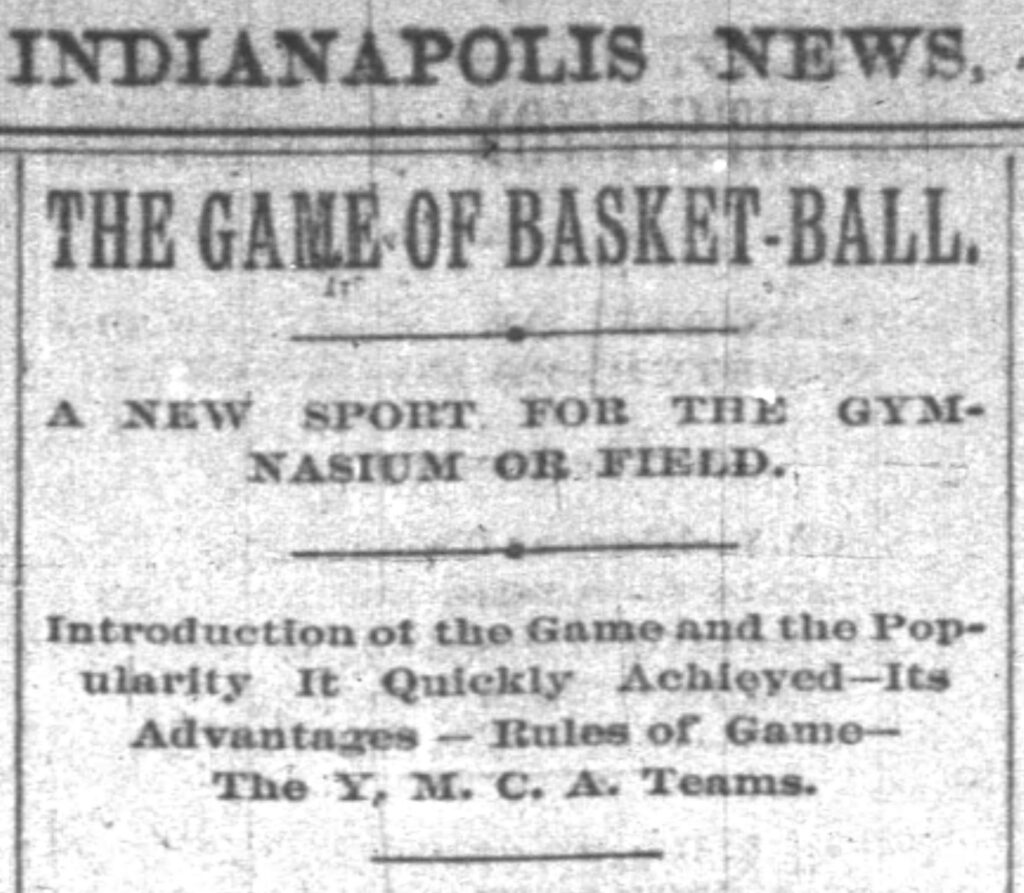
It is interesting that the first full classes offered at Oakland City College, in Oakland City, Indiana, began the same year that Naismith introduced basketball to the world. In many respects, Oakland’s story of its initial interest and growing devotion to the game stands as a prime example of how the sport spread and how the specifics of the game evolved in the nation and the state—with the Y.M.C.A. being the ongoing catalyst for early basketball competition.

In 1895, a report in the Indianapolis Journal showed Oakland City had requested a Y.M.C.A, “organization at Oakland City College.” By 1899, William Dearing, the OCC college president, spoke in fervent terms to the Princeton, Indiana, Clarion-Leader about the organization. “We have a splendid organization in our college at Oakland City, and I would say we would not be without it for anything.” Although the fledgling college lacked a gym or a team at this time, Y.M.C.A. instructors often came to the Baptist campus to preach and to teach, among other things, the religion of basketball. This same drama would occur throughout the state, as the Y.M.C.A. system spread the game far and wide. Oakland City’s time would eventually come, but not before the game saw some changes.
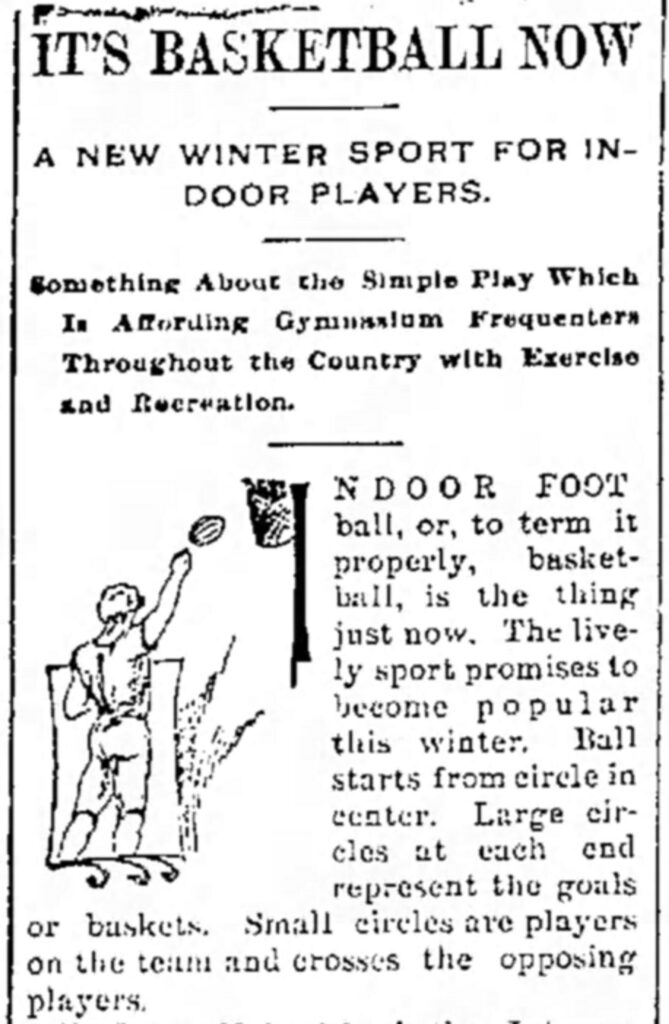
It should be remembered that in the early 1890s basketball had yet to arrive at the form we recognize today, being much more static in its first stages. For example, an Indianapolis News article explained the ball could best be moved by passing from one player to another, and there were nine positions on the floor. The positions included: Right Forward, Left Forward, Center Forward, Centers (3 positions), and Right Back, Left Back, and Center Back. The initial rules, however, did allow a configuration for five players for smaller gyms. By 1899, things were already changing, the Indianapolis News, listing the Indianapolis and Terre Haute Y squads as having five starters: two forwards, two guards, and a center. This seemed to be true in the nation as well; a Philadelphia Times sports article reported in 1898, “No matter how large the gymnasium five men alone are always used. A basket just large enough to receive the ball is placed against the wall ten feet above the floor at each end of the floor.”
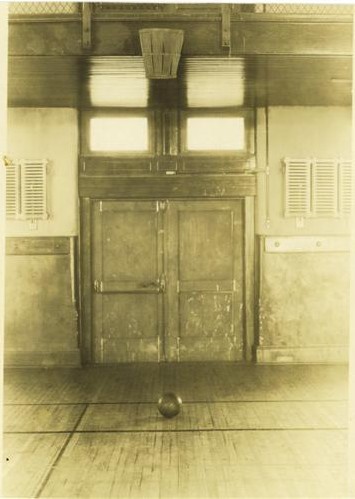
Other Indiana newspaper stories about the rules of the novice but popular sport appeared all over the state, not all of them reporting the same “facts” about the game. The Logansport Pharos-Tribune in 1895, for example, explained, “Indoor football, or, to term it properly, basket-ball, is the thing just now. . . . The game is played with a small rugby or association football and the baskets hung at either end of the hall must be large enough for the ball to pass through. The basket is hung about eight feet above the floor.” The report further illustrated a shot being attempted by a player throwing what looks like a football toward a basketball goal.
Even in the deep southwest corner of the state, the home of Oakland City College, the game seemed to have become an instant success, basketball contests occurring as early or earlier as in Indianapolis. The Evansville Courier observed in 1893, “A large number of ladies and gentlemen gathered in the Young Men’s Christian Association parlors last evening, making their way to the gymnasium to view a spirited game of basketball. The space in the running-track was occupied and many persons found their room in the gallery.” In another article that same year, one explaining the rules of the game, the Courier noted,“when a goal is made, the game goes right on. It is perhaps the fastest game played today and played with a snap which football linemen in lining up may well envy.”
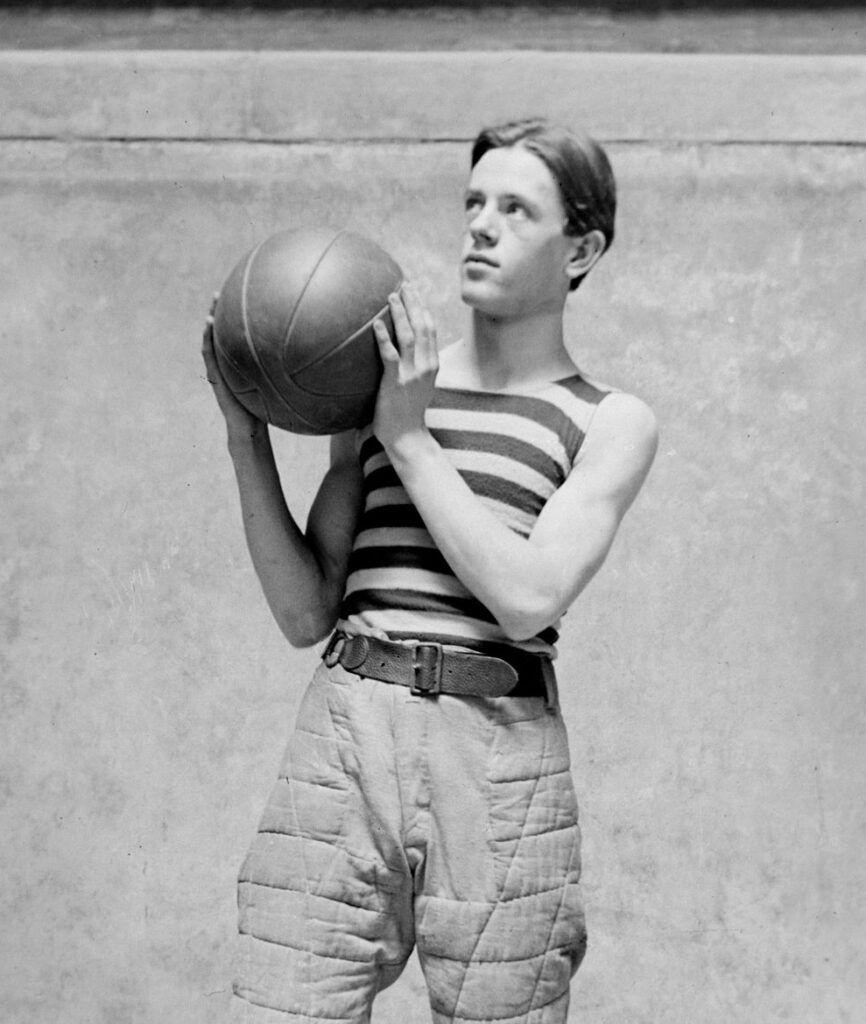
For a while, the lack of playing floors large enough to accommodate a basketball contest probably limited the game’s growth. Nevertheless, large barns, lumber yard buildings, and even small-town “opera” houses were quickly converted into make-shift gyms. The situation of a lack of decent playing floors, however, kept Y.M.C.A. locations at the center of focus when it came to basketball in the state. Y facilities most often had “large” gymnasiums for that day with running tracks above the gym floors from which basketball goals could be hung. The Y clubs also continued to try and keep a consistent set of playing rules.
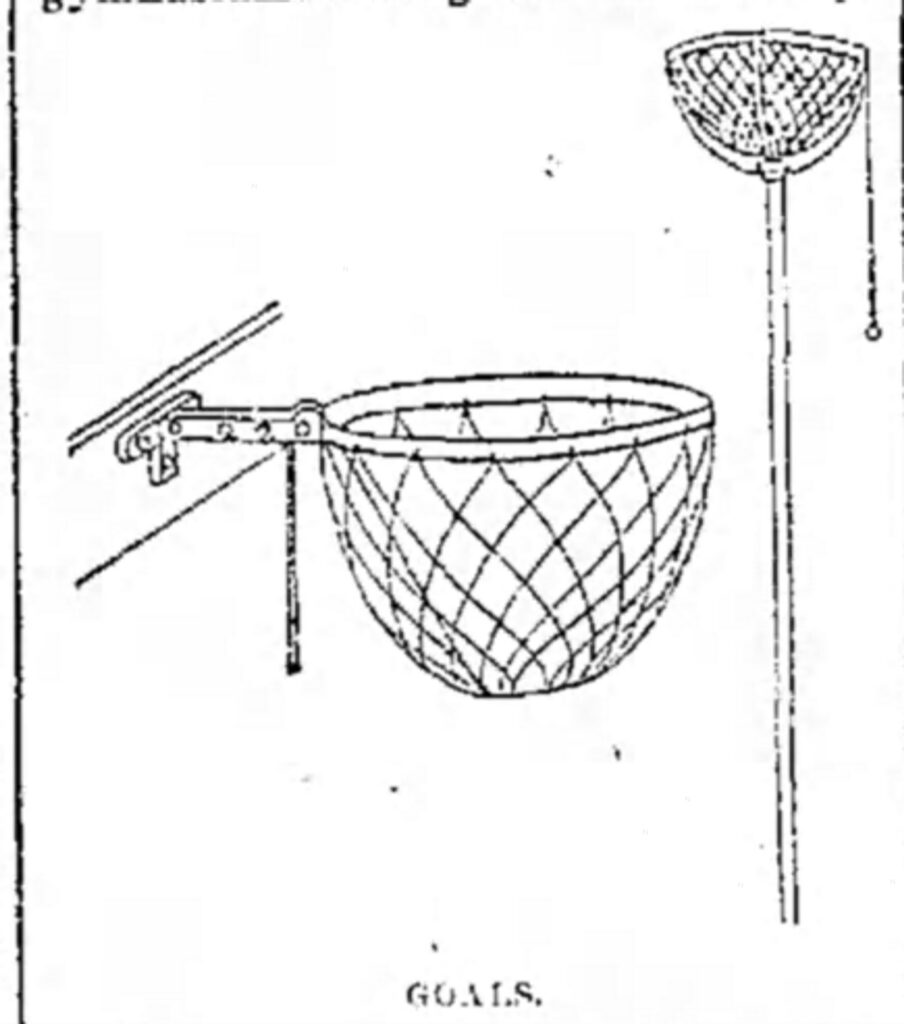
But there did exist an early tension between Y.M.C.A. rules and those among other groups such as the Amateur Athletic Association and professional teams. The Y.M.C.A. stressed team play, an emphasis that led to a regulation that was reported in newspapers across the country. A New York Sun sports article in 1898 noted, “A man cannot dribble the ball down the floor, even with one hand, and then throw a goal. He must pass it. The game must remain what it was originally intended to be—a passing game.” The Decatur, Illinois Daily Review also observed in 1899 about the disadvantage of constant dribbling. “A heavy man who is a rapid runner by this means can generally succeed in getting down the field and having a try for a goal no matter what the opposition may be.” A Saint Paul Globe sports report in 1900 added that this rule was made “with the object of making the game more open, to eliminate individual playing, and to promote that most important feature of the game—team play.”
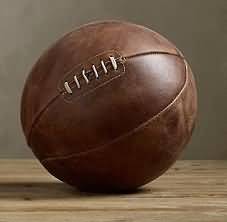
Other sports writers across the nation disagreed with the Y.M.C.A. notion about constantly passing in order to advance the ball, a Trenton Evening Time reporter arguing that “when clever blocking and brilliant dribbling are stricken absolutely out of the game, half of the brightness, speed, and fascination is also gone.” The Philadelphia Times chimed in in 1898, noting, “A player retaining the ball and advancing the sphere by dodging or dribbling is one of the game’s finest points, and almost invariably has the desired effect of bringing audiences to their feet.”
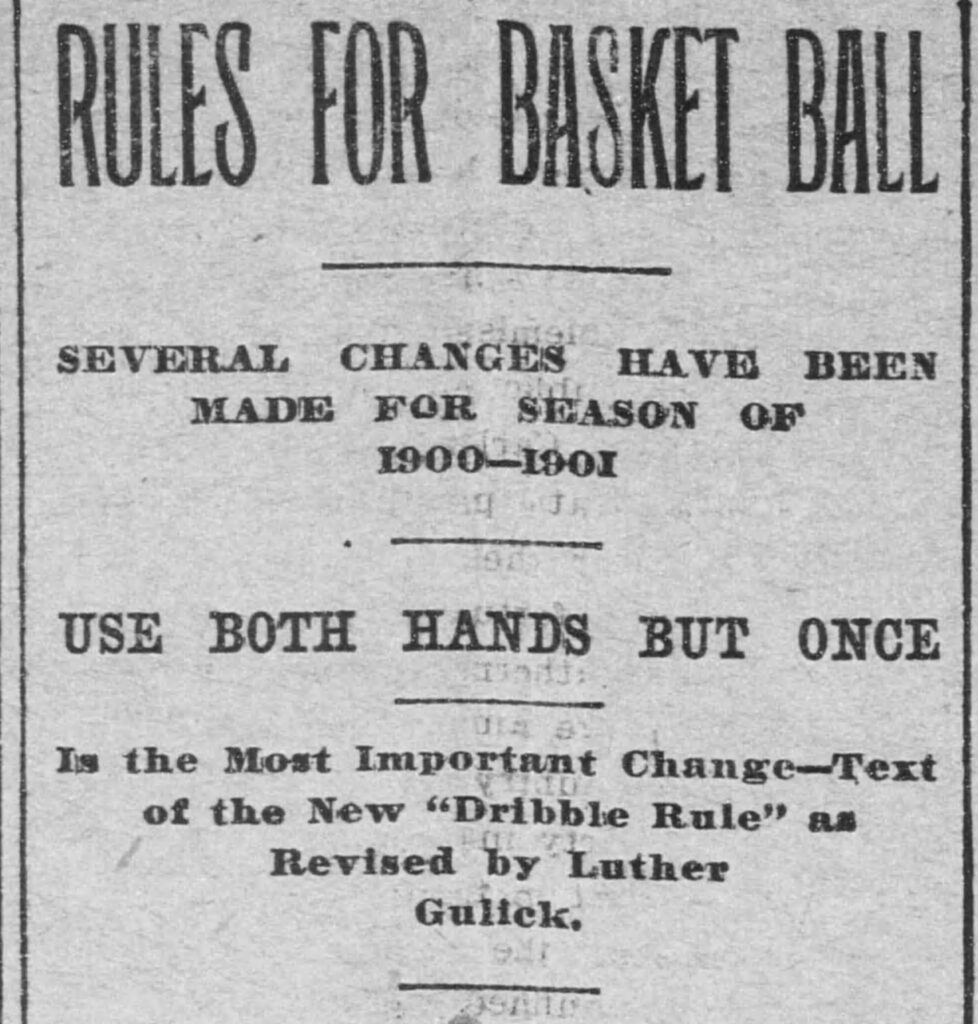
Hoosier basketball, however, quickly leaned towards the faster playing style, and by 1906, Indiana colleges, to clarify the situation once and for all in their league, officially legalized the dribbling of the ball and shooting for a goal without passing, a practice the Star Press in Muncie noted had not been paid much attention to anyway.
___________________________________________________________
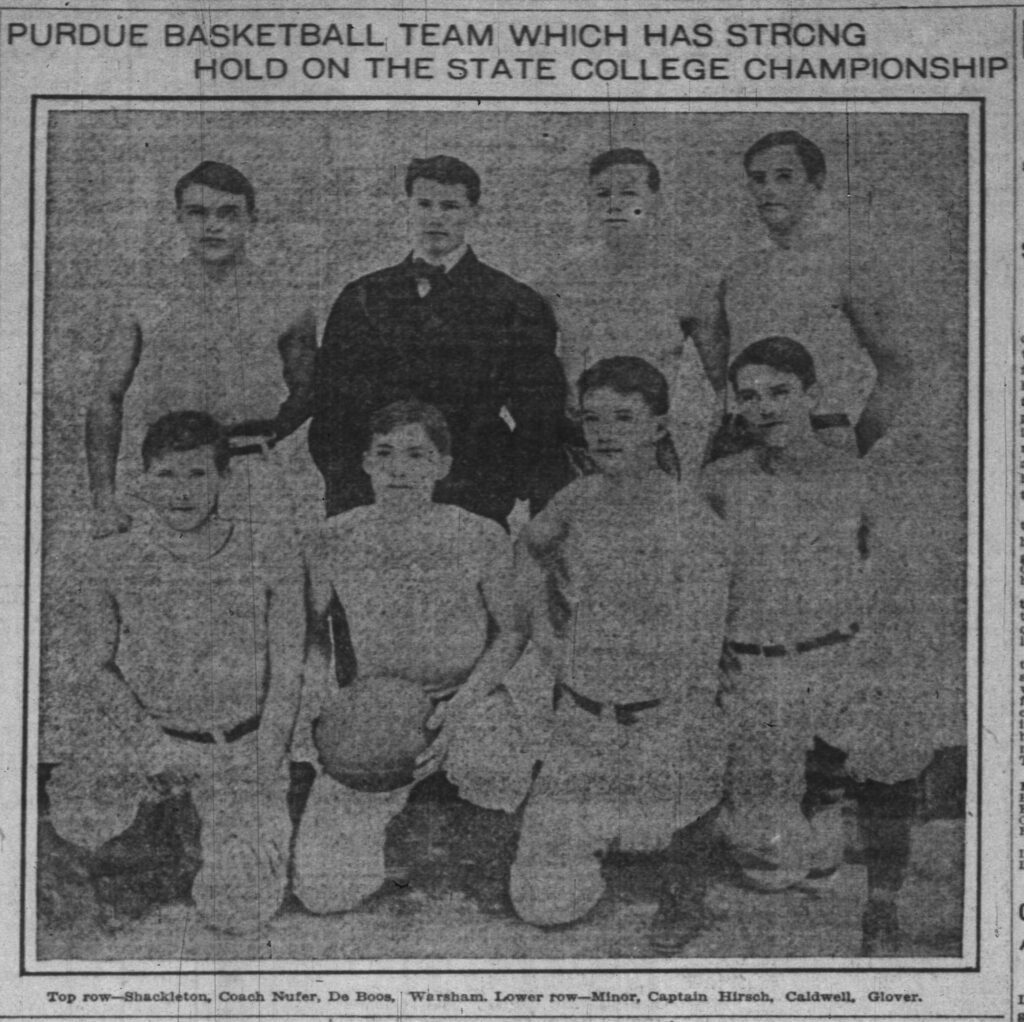
Early on in Indiana, many high school teams, amateur independent squads, colleges and universities, and Y.M.C.A. clubs formed schedules which often included a mixing of competition among all these groups. A 1902 sports article in the Indianapolis Journal, for example, reported that the Indianapolis Y.M.C.A. beat Shortridge High School while Manual Training High School won over Butler University. In that same year, the Indianapolis News carried a story of the city’s Y.M.C.A. team’s victory over Notre Dame, explaining, “The Y.M.C.A. five was not in danger of losing at any stage of the game.” In an 1907 article, the Indianapolis News noted that state championships among these different groups were based on winning records within the different categories.
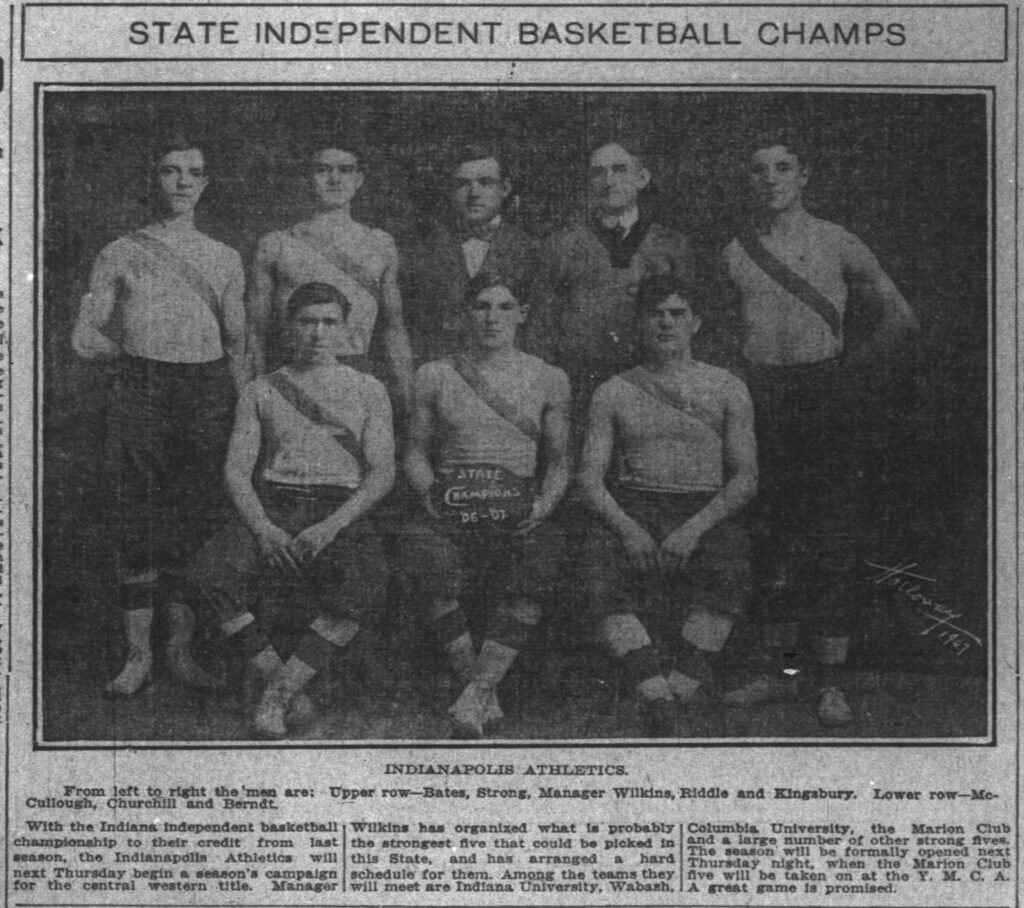
This mixing up of team competition among different types of institutions was also true in the southwest corner of the state. In 1904, an Evansville Journal News article entitled, “Basket Ball is a Splendid Game,” reported that the Evansville High School team was playing in the local Y.M.C.A. league, along with Lockyear College, the local Y club, and the Courier newspaper team.
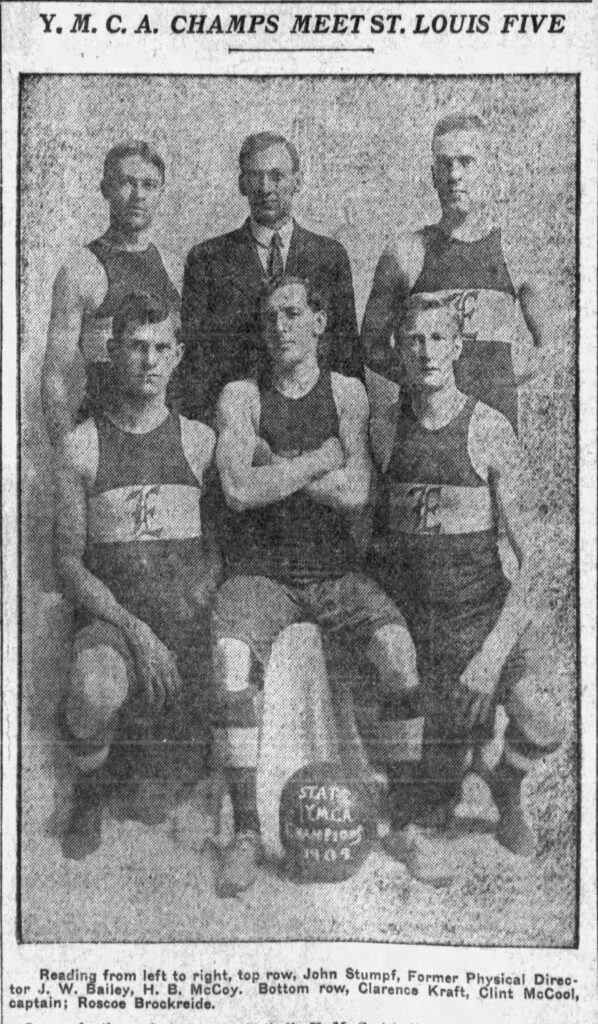
Meanwhile, in the same region as Evansville, recently created Oakland City College was beginning what would be its own long tradition of collegiate basketball, a tradition that would also include a variety of opponents. But the school’s basketball journey would not be an easy one.
Oakland City College had what was probably the smallest gymnasium in the state, and much of their success may have been due to the small size of their first playing floor. Opponents disliked playing there. The gym was located in the basement of a 1900 addition that had been added to the original 1885 administration building. The playing space was far under regulation size, having a low ceiling and two iron posts in the center of the concrete floor, and no out-of-bounds lines. Only a few fans at a time could watch the game, sitting on the floor at a small area at the north end of the court, or by watching contests through the basement windows.
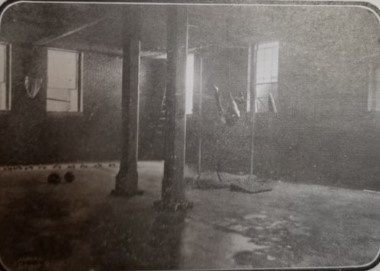
Detailed records of the school’s first few years of basketball competition are difficult to come by. The first Oakland City College game this research uncovered was reported in the Indianapolis News, a preliminary game to the headlining high school contest between Evansville and Oakland City high schools in January of 1906. It was hardly an auspicious start for the college squad. In the contest, the college played against “the clerks of the city,” a game the college team lost 6-3. Another newspaper account, this one in the Evansville Courier, indicated Oakland City College had at least one game in the late fall of 1906, a contest the Oakland crew lost to a Spurgeon independent team at the tiny Oakland gym. A Courier reporter noted,
The Spurgeon independent basketball team defeated the Oakland City College team at the college gymnasium by a score of 28-8. The game was interesting from start to finish, and was marked by clean, swift playing on the part of the visitors, who outclassed the home boys at every position. McKinney, the Spurgeon center, made it impossible for Mangrum, the college star, to make a single goal.
Other newspaper articles also gave evidence of OCC’s early basketball existence. At the beginning of the 1907 season, the Evansville Journal News reported that the Evansville Citizens Club had invited representatives of basketball teams throughout the state—high school, college, and Y.M.C.A. teams—to come share their school teams’ latest cheer yells to the crowd. “The various colleges, some of them normal schools, the Evansville High School, the Evansville Y.M.C.A. and the Oakland City College representatives went at it . . . bombarding each other with yells long and short, intelligible and otherwise.”
In December of 1907, the Oakland City College team “defeated a mixed aggregation in Lynnville by a score of nine to eight” (Article in the Boonville Standard). One of the Oakland players, Henry Crecelius, later remembered that season in an article in the Oakland City College Collegiate. It should not be surprising that the person who led the effort to start a basketball team at Oakland City owned the only basketball.
In 1907, Elmer Jenkins, an enterprising young OCC student received the blessing of President W. P. Dearing to start a basketball team. Jenkins brought the basketball and organized a five-man squad. We played in the “new gym,” not the big one built in 1922 but the very small gymnasium located in the basement of the Administration building. The crowds were large enough that sometimes the games were played at the Opera House located at Harrison and Main Street in downtown Oakland City. Uniforms were cut-off khaki pants.
By the 1907-1908 season, newspaper accounts showed Oakland City going up against the likes of Vincennes College, the Evansville High School team, a hand full of other high schools, a few Y.M.C.A. squads, and local independent teams. The OCC “blue and white” squad was termed “fast” in an Evansville Courier article just before a big game with a strong Evansville Y.M.C.A squad. The college team roster was listed in the newspaper article as E. Cox, right forward; E. Jenkins, left forward; C. Mangrum, center; L. Richardson, right guard; and B. Turpin, left guard. J. Anderson was listed as a utility player. At the end of the season the Indianapolis News announced the Oakland five had achieved a sparkling 7-2 record.
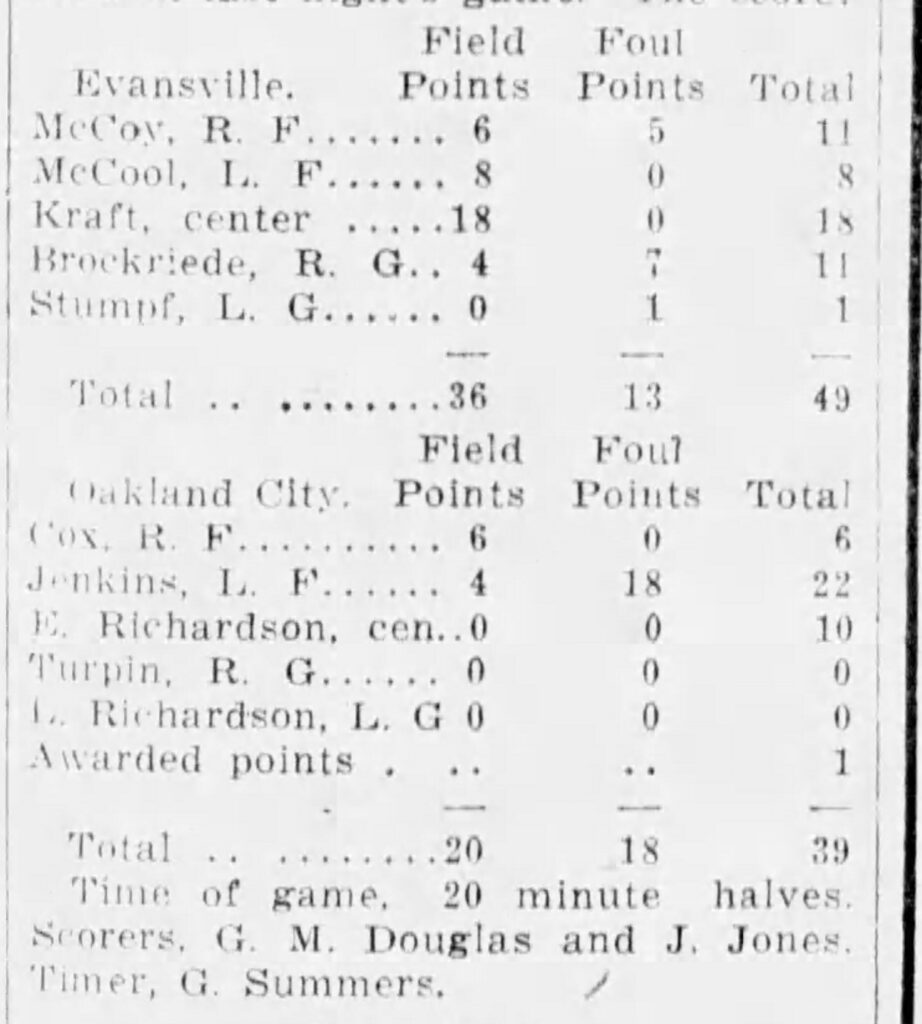
The next season, 1908-1909, witnessed Oakland City joining a basketball league for the first time, the Evansville Y.M.C.A. Central League. In the initial four team group were OCC, Vincennes University, and the Henderson and Evansville Y.M.C.A. squads. Later, Vincennes University would pull out and be replaced by the Owensboro Y.
The Evansville Press had this to say about the impact of the new basketball league. “Never before in the history of basketball in the city have fans taken so much interest in the sport.” Part of the previous lack of interest, according to the Y director, had to do with how tough the Evansville Y team was. “Evansville has always so easily outclassed its opponents that the fans could hardly be interested,” the director told the reporter. The Press sports reporter pointed out, however, “In the central League, things will be different. Oakland City has probably the strongest college team in southern Indiana.”
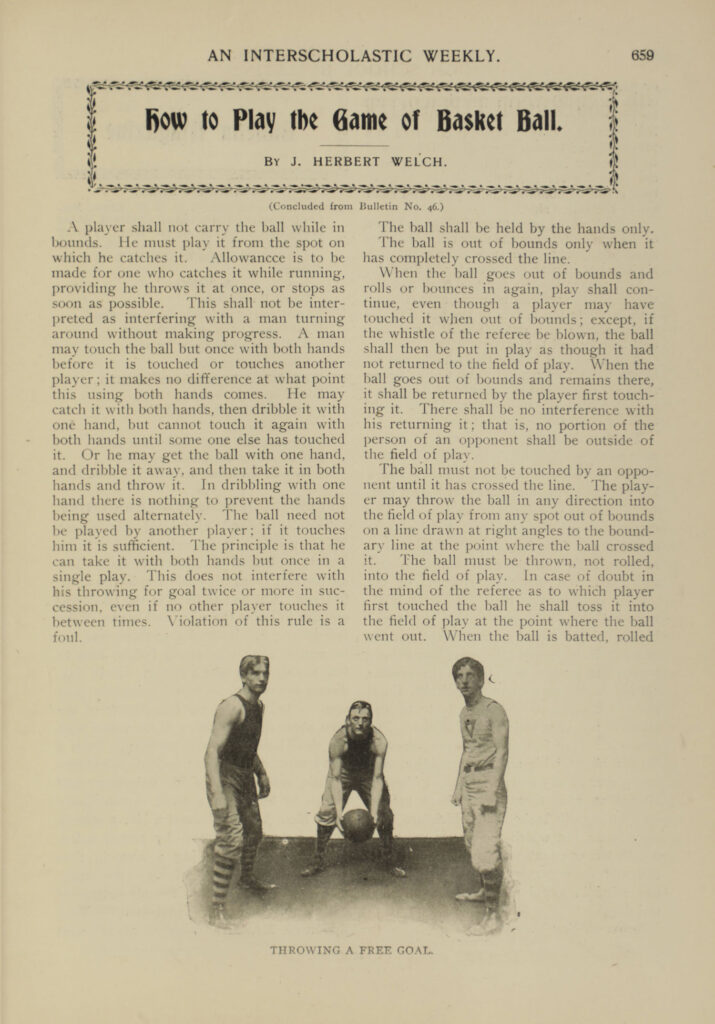
It was within this league too that OCC gained its first regional rival: The powerful Evansville Y.M.C.A.
The two squads were the best teams in the league by a long shot, Oakland City being undefeated and leading the league before their first game with Evansville in late January, just before the rivals met for the first time on the Evansville Y.M.C.A. court. That event was heralded by local newspapers, and then covered in detail the day after the game.
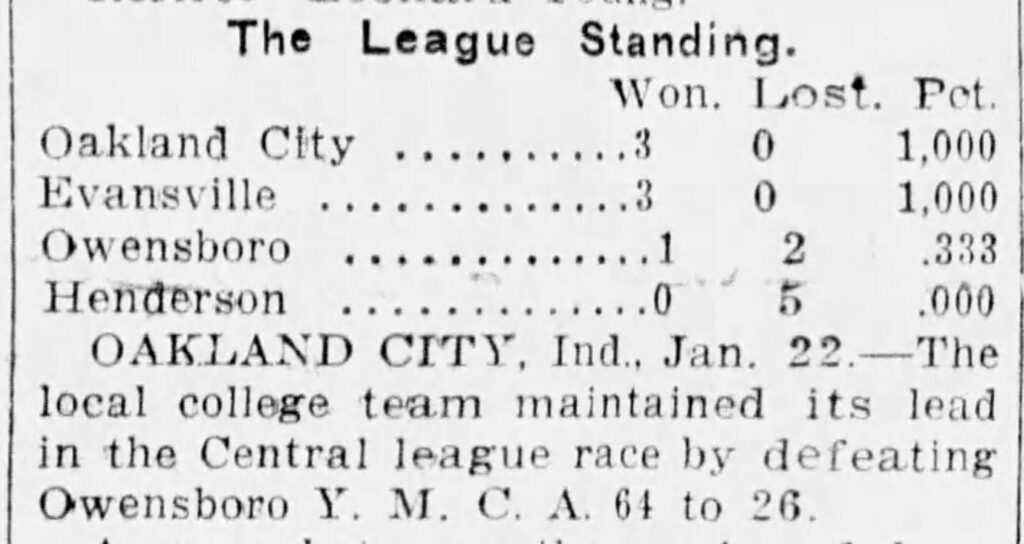
The day after the epic Oakland City-Y.M.C.A. battle, the Evansville Journal News declared in its headline, “Great Game of Basketball: Y.M.C.A. Defeats Fast Oakland Team,” while a Evansville Courier’s sports headline announced: “Collegians Lose Hard, Classy Fight: Evansville Basketball Stars Given the Tussle of Their Lives by Oakland Huskies.” Both papers explained how the lead changed several times during the game, until the final few minutes, when Evansville pulled out a 49-39 win. The Courier reporter called it “One of the hardest games ever played on the local floor.” Spectators, the detailed article further noted, were completely involved, especially “a bunch of vocal college rooters.”
The Journal News reporter’s descriptions of the contest were perhaps the more colorful piece, the writer observing in part,
Outside it was biting cold and a blizzard raged. Within, excitement was at a fever pitch as ten perspiring players steamed over the court in cyclonic style, first one team holding the advantage and then to be passed by their opponents. It was a great game, full of clever individual work by every contestant, with occasional flashes of splendid teamwork, only to have the machine game broken down by hard, close hand checking. Time after time the spectators, of whom there were a large number present despite the disagreeable weather, were forced to their feet to yell themselves hoarse at the dashing play displayed by both fives.
These reports of the game suggested that Indiana basketball was quickly evolving into a faster paced game, one that could leave even the fans exhausted but satisfied.
The Evansville team’s victory over the Oakland City College crew was no fluke. In 1909, the Evansville Press reported that although the Oakland City College team “put up many stiff games, the college men were unable to defeat Evansville during a two-year period.” A 1911 sports article in the Evansville Journal News was even more revealing. “The local team has lost but one game in three years and that was by one point. With the exception of McCoy, who is an old Indiana University star, the players were all developed at the Y association. Kraft has been a member of the Y.M.C.A. since 1904 and he and McCool have played together for the last seven years.” In this respect, many Y.M.C.A. squads like the Evansville crew, having played together over long periods of time, possessed some of the qualities of professional teams, and the Oakland City College team could never seem to get over the hump when playing against their Evansville rivals.
The 1909-1910 season had its share of victories and defeats for the Oakland team. The Evansville Courier noted that the Oakland City College men won three out of four games with Moores Hill College, the forerunner of Evansville College. The Indianapolis News reported that “Oakland City College defeated Vincennes University at basketball on their local floor last night in a fast and interesting game. The score was 34-24. The college won by their sensational goal throwing.”
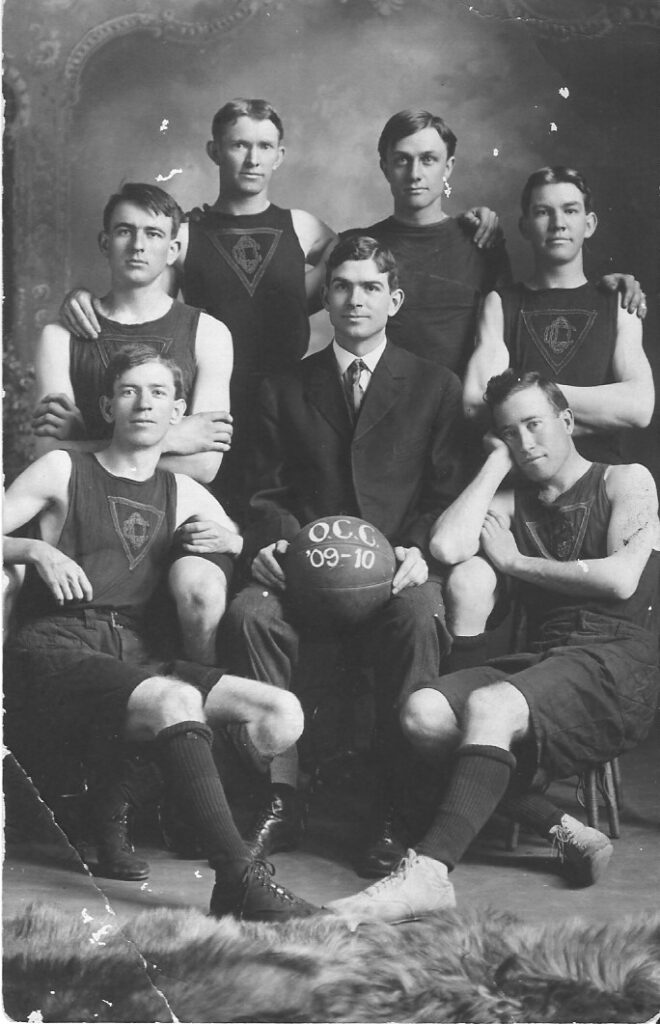
There were, however, two heartbreaking losses to the Evansville Y team that season. Oakland’s Evansville foe was apparently riding high even before their first contest with OCC, the Evansville Courier reporting, the team “has selected pretty suits which they will shortly receive. Black shirts with a six-inch gold band about the chest and stockings to match with white basketball pants have been chosen as their suits.”
The less well dressed OCC squad lost the tilt at the Y.M.C.A. gym, but hoped that they might at least win at their place, as they would have the advantage of their extraordinarily small gym. This was not to be, even though the Evansville Press noted the Y team players “were handicapped by not being familiar with the cramped surroundings.” In the end, despite the foreign gym, the Y finally pulled away by a 45-31 score.
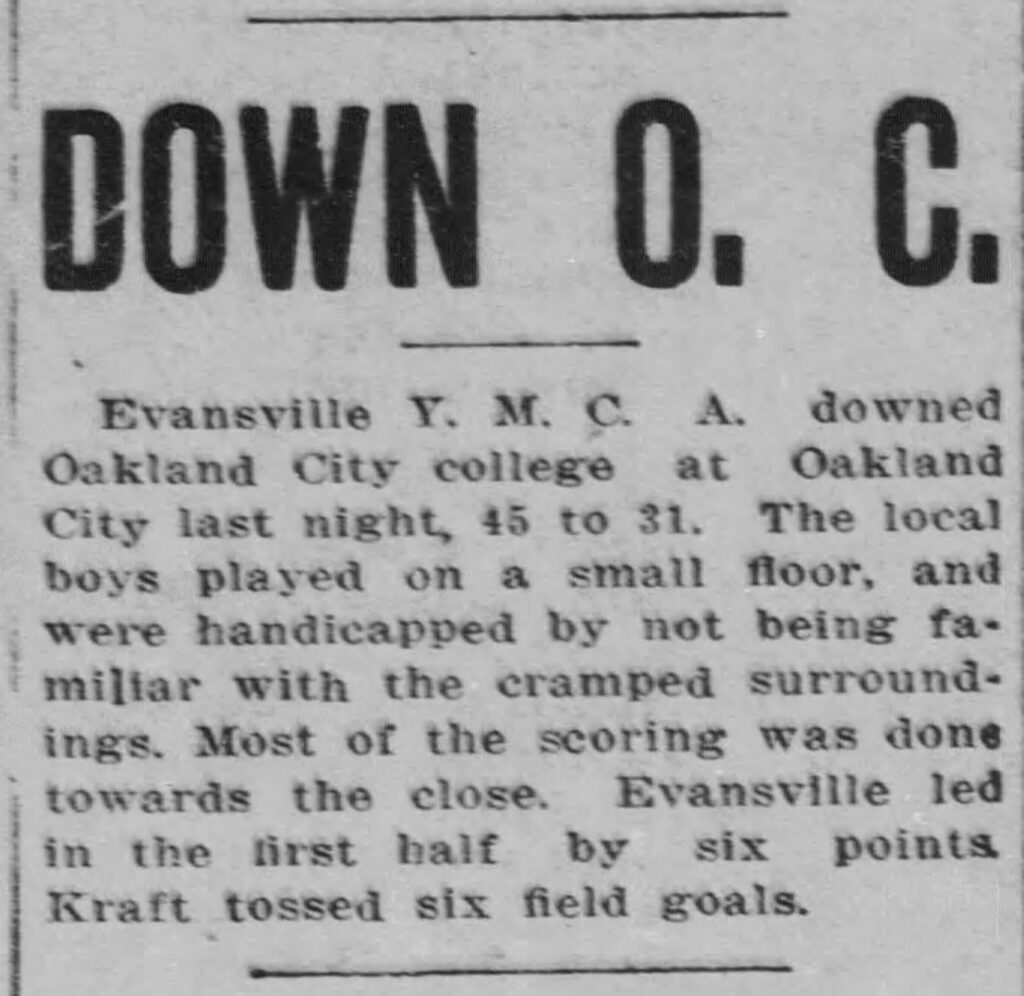
The 1910-1911 season may have been the high point for the Oakland City College basketball team during the school’s first decade and a half of basketball play. That season found OCC with another rival, as the Evansville Journal News announced the city’s high school would have a full schedule with other high school teams in the area and with Oakland City College. The high school squad ended up winning the southern Indiana high school championship, beating all comers, and advanced to the first Indiana High School Athletic Association basketball state tournament in 1911. In their first game of the season at the Y gym in Evansville, however, they faced a strong Oakland City College team. Still, the Journal News reported “a victory is expected.”
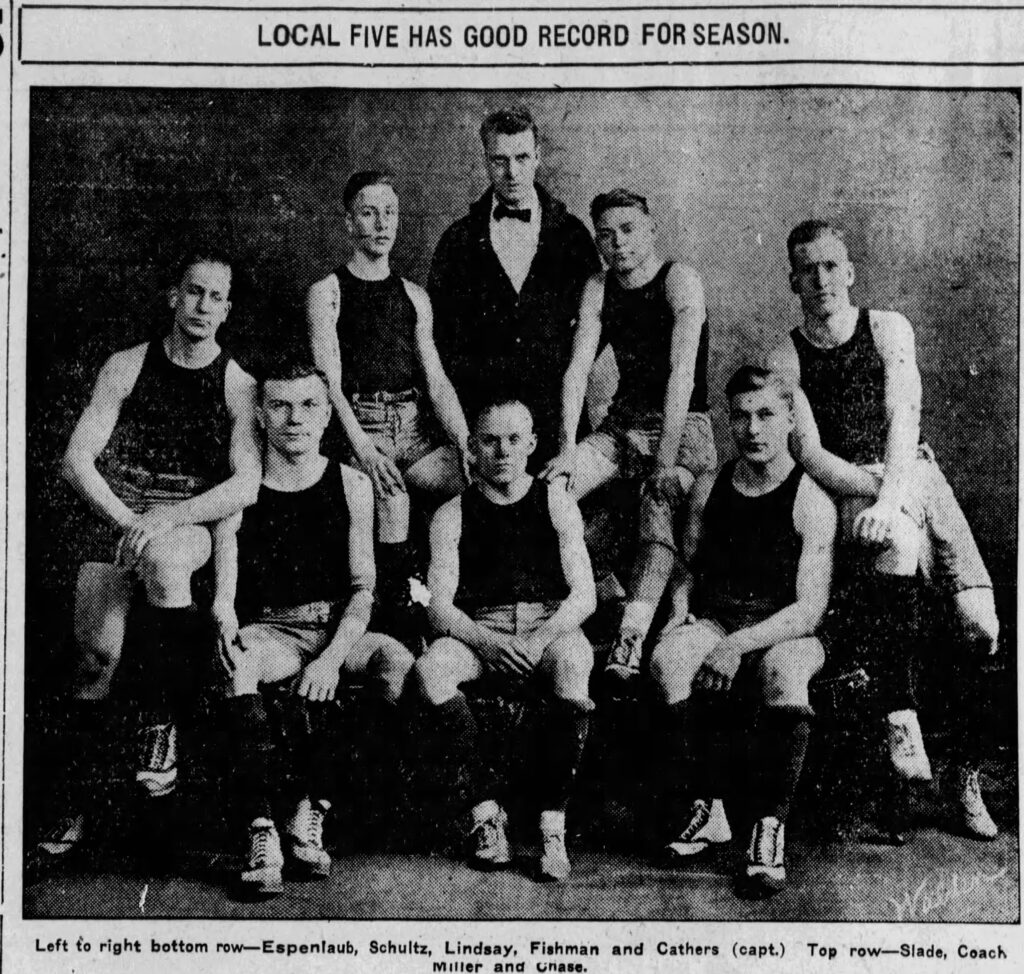
It was a rough game, rougher for Evansville. A sports reporter for the Journal News thought the Evansville players a bit over-confident, taken by surprise by the fast OCC squad that quickly ran up the score, leading by 29-4 at halftime. “The last half was marked by rough playing and hard fighting.” The final score was 55-14 in favor of OCC. The Oakland players were listed as Forwards: Cox (captain) and E. Richardson, Center: Trible, Guards: Wilson and Morris.
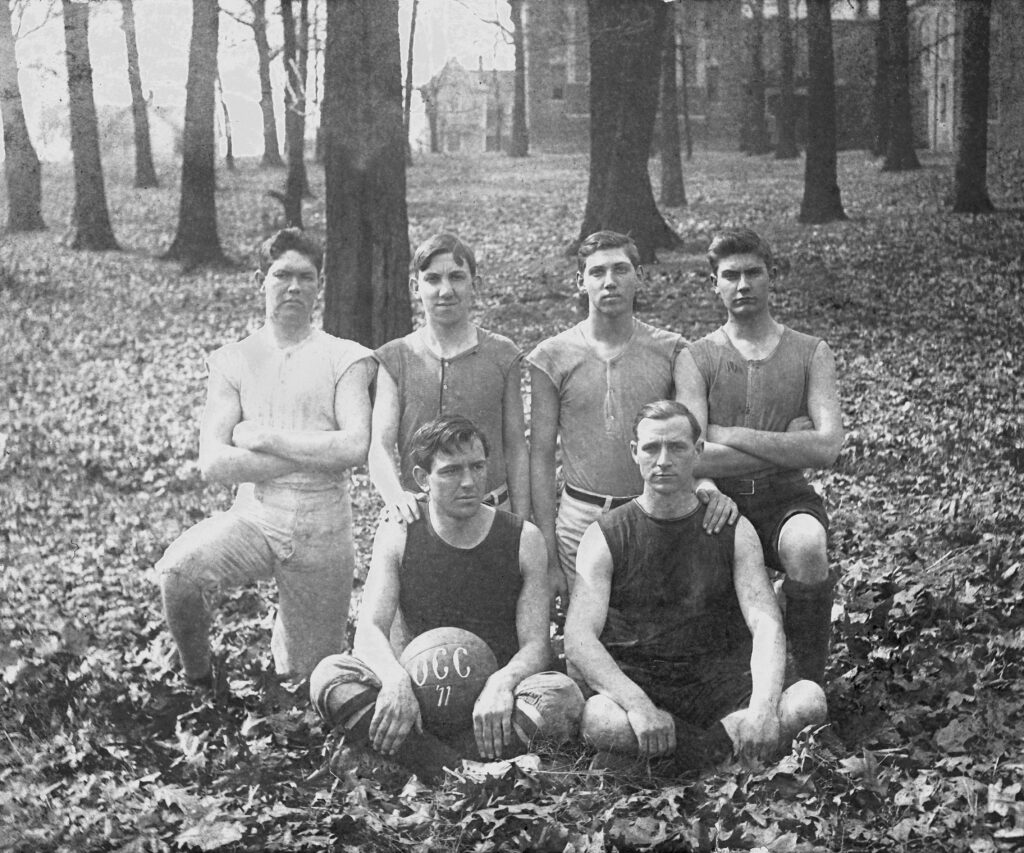
The second game between the new rivals was played in OCC’s gym. The Evansville Courier reported that the Evansville five, “showed a decided improvement over their form in the first game with the Oakland City College team,” a nice way of saying the Evansville squad lost.
OCC’s bitter Evansville Y.M.C.A. rivals were up next, with the game to be played in OCC’s difficult gym, and while a sports reporter for the Evansville Courier bragged about the rarely defeated “state champion” Y.M.C.A. team, the same writer also warned,
The Y.M.C.A. “big five” basketball team goes to Oakland City to play the crack college quintette tonight which ran up a 51-15 score against the Evansville high school shootists last Saturday on the local court. The collegians are a strong combination of height, shooting ability, and teamwork, and should make the Y.M.C.A. team extend itself to have a winning margin.
The next day the Evansville Press reported the Evansville squad won a close 46-42 game. Two weeks later, the city’s Journal-News indicated the Evansville Y crew and coach were taking no chances in the next match with their rugged rivals.
Next Friday night will witness one of the fastest games of basketball ever pulled off on an Evansville floor, when the Evansville Y.M.C.A. five meet the aggregation from Oakland City. The Evansville five is in excellent condition and will put up the fight of the season. Almost daily practice is putting the team on edge for the battle.
Unfortunately, the Oakland squad lost once more to the power packed Evansville team. The OCC team would go on to win a majority of their games that season.

For unknown reasons, reports of OCC basketball games are harder to find in newspaper accounts after the 1911 season. College yearbooks also had yet to appear. Part of the problem may have been caused by the coming of WWI in 1914, including an increase in flu epidemics, even before the 1918 outbreak. A 1912 article in the Evansville Press showed OCC losing a game 31-28 to the Y.M.C.A. “second” team.
After that, an articles showed in the 1915-1916 season that the college team lost to Oakland City High School and to Evansville High School, the latter game by a score of 49-9. In a subtle reference to the advantages and disadvantages of Oakland City playing its home games on its tiny floor, an Evansville Journal-News sports reporter wrote that the OCC squad, playing on Evansville’s large floor, “started out in a rush but the big floor and the fast play soon tired the visitors.”
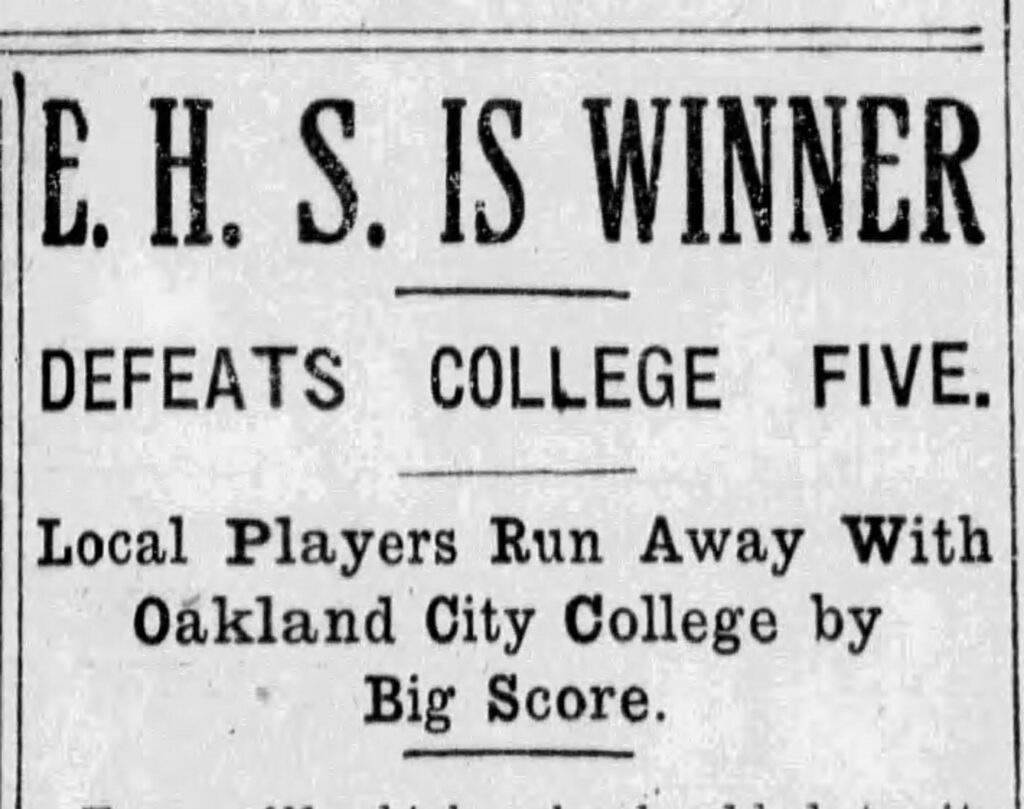
The next year there was a report of OCC defeating Lynnville High School on the OCC gym floor, the Lynnville squad complaining of “the college team’s floor, which was very small.” Patoka High School beat OCC that year,however, 28-16. After that, there was one report of Winslow High School going undefeated for the season after beating the Oakland City College squad 32-13 in 1919. The first college yearbook in 1919 also showed the college playing only four games, and those against high schools, OCC ending up winning three.
The beginning of the 1920s would bring a rebirth of basketball to the college, the state, and the nation. Oakland City College would also gain a new rival–fledgling Evansville College which started its first sports season in 1920.

Like many strong and dramatic sports rivalries, this one had a back story. When it was purposed around 1916 by the leaders of Evansville to create a college there, articles soon appeared in cities newspapers critical of nearby Oakland City College, claiming it was not a “standard” school recognized by the state. Oakland City College President William Dearing quickly wrote a letter to the editor Evansville Courier, pointing out this information was in error, a portion of which is seen below.
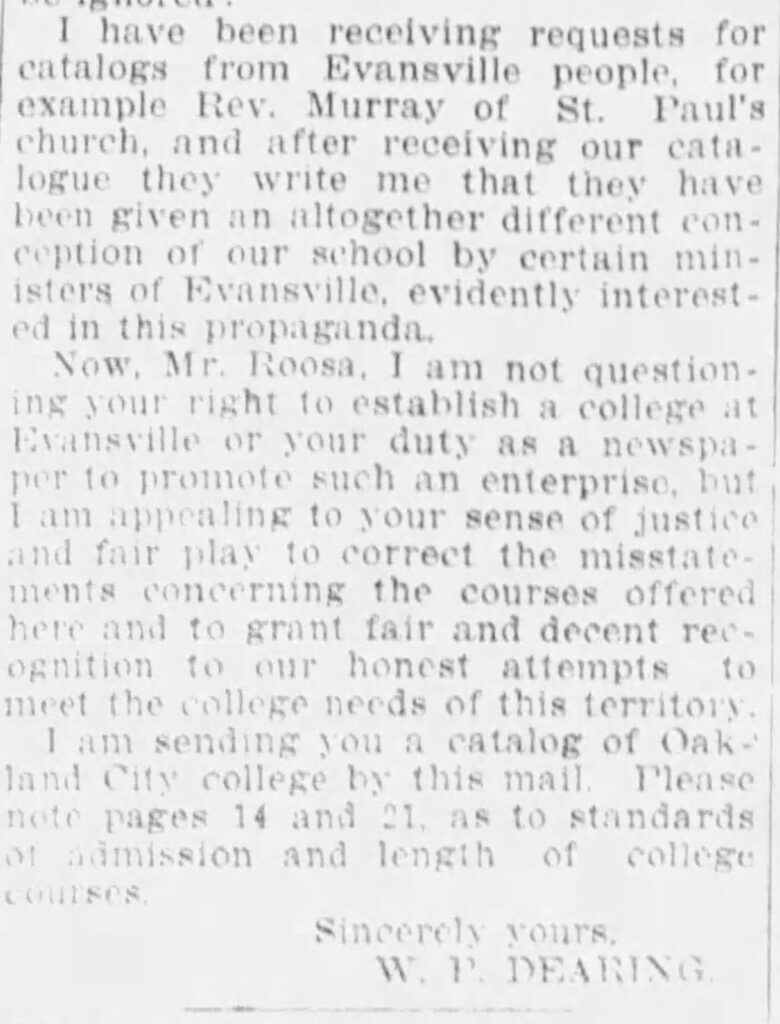
The fight was further accelerated when an Evansville newspaper announced that a regional philanthropist and financial supporter of Oakland City College, Jacob Cronbach, was in complete favor of Evansville College. Cronbach quickly wrote a letter to several newspapers (see Boonville Standard article below) that this was not so. His love and support was for Oakland City College only.
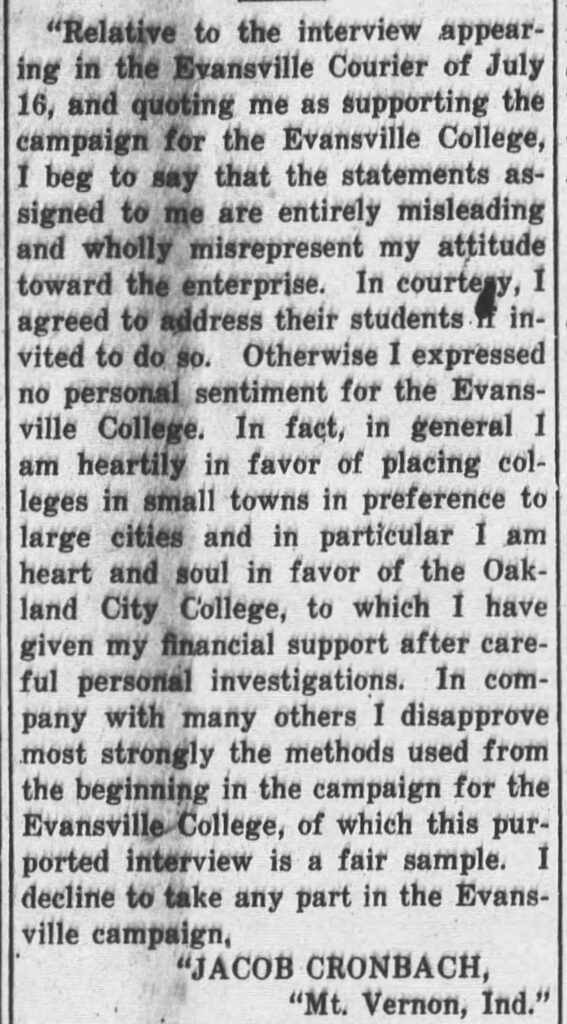
The new school did not fare any better on the basketball court when it came to playing OCC. The Evansville Journal sounded the alarm during the 1920-1921 first season for Evansville, just before Evansville and Oakland met on the basketball court, pointing out that the Oakland squad had won its “sixth consecutive basketball game.” While this information may have made the Evansville team practice harder, it apparently did little good.
Evansville College, later to become the University of Evansville, lost to Oakland City College in their very first contest, 24-22 in a spacious Evansville gym, an environment the Evansville crowd thought would lead to an easy Evansville win. It was a bitter loss to swallow. The Evansville Press sportswriter headlined the game, “E.C. Almost Won,” and argued the Evansville squad would have won had they not lost their captain to “too many personal fouls.”
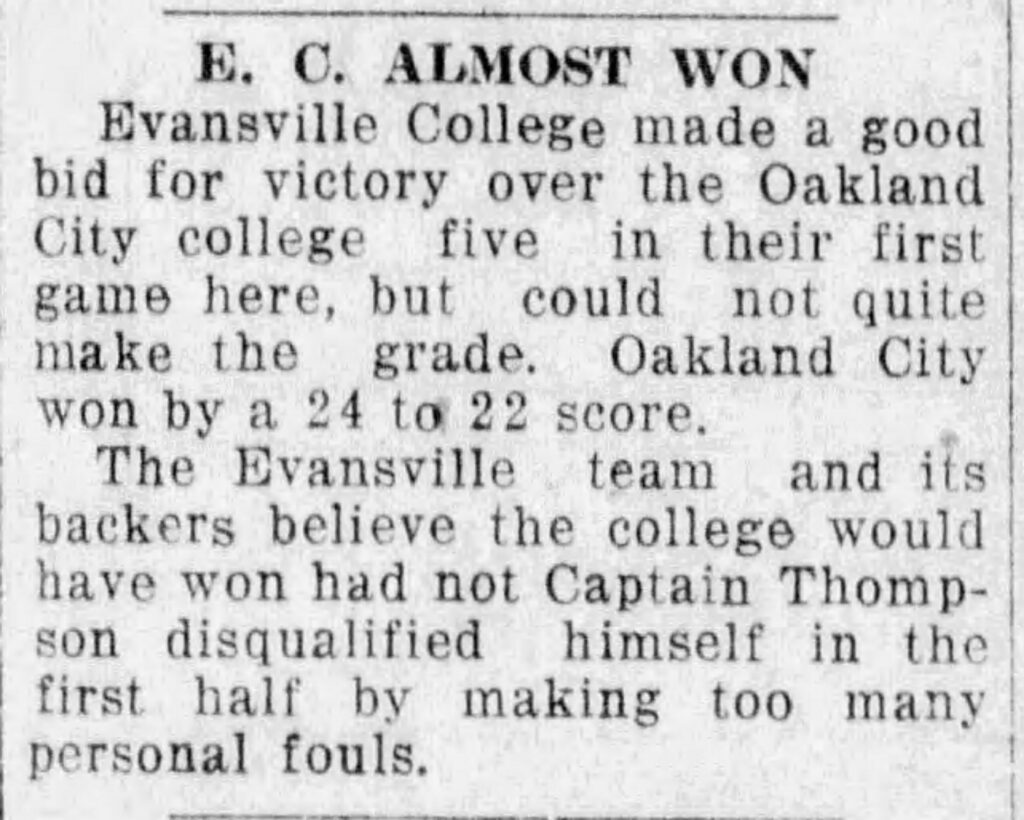
Tensions rose as the second game approached. The Evansville Journal mentioned that the Evansville team was “bringing 100 rooters and much enthusiasm will be shown on both sides.” But the newspaper also went on to lament,
Use of a small court will handicap the Evansville basketball team in its game with Oakland City College at Oakland City. Accustomed to playing on a large floor the small floor should prove somewhat of a hindrance to Evansville players. Efforts on the part of Dean Torbet, to obtain a larger floor for the Saturday game than is ordinarily used at Oakland City were of no avail.
The Evansville newspaper’s comments were prophetic, the next day’s newspaper article telling,
After the Evansville team and its backers were royally entertained Saturday afternoon by Oakland City College, OCC reversed her procedure and beat the Evansville men 24-3. While the Evansville men played a little better game of basketball, the gymnasium, far under regulation size, low ceilinged, with two iron posts in the center and no out-of-bounds lines, spelled defeat for the purple and white. Because of the poor playing conditions, accidents were enormous.
The paper certainly was not wrong about the injuries. Two players from each side left the game after being knocked silly by violent collisions.
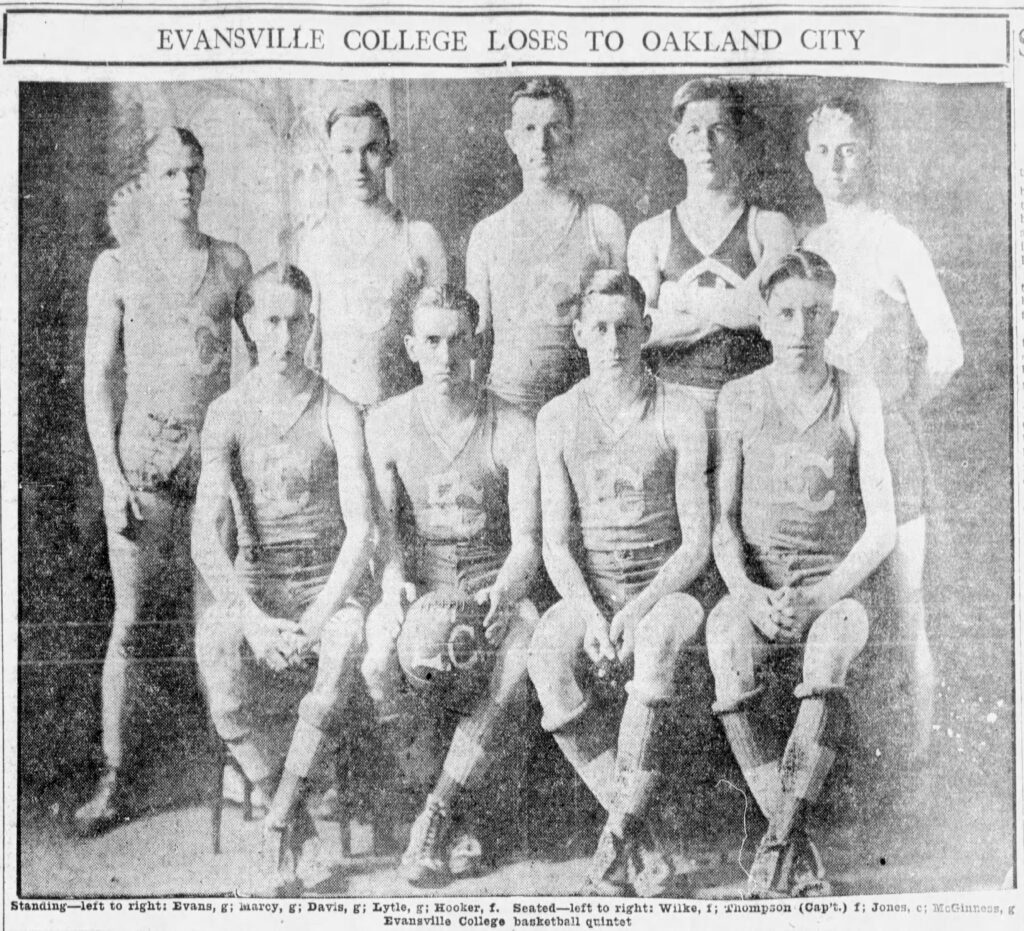
____________________________________________________________________________________
The continuing decade of the 1920s would witness something of a golden age regarding sports at Oakland City College, in those heady years leading up to the Great Depression. Part of this success in basketball involved the building of a much larger gym in 1922. OCC would also develop excellent baseball, track, and football teams.
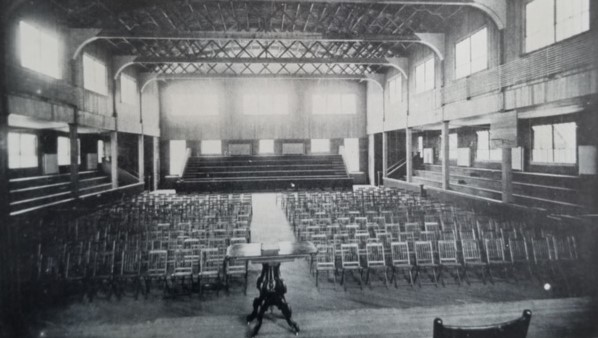
The basketball team would also continue its domination of Evansville College during this time, while playing other Indiana college teams such as Wabash, Hanover, Rose Polytechnic, Valparaiso, and Indiana Central, and a few university teams, including Indiana State, Southern Illinois University, the University of Louisville, and Ball State. Gone from the schedule were the former overloads of high school and Y.M.C.A. institutions. Oakland’s 1926-1927 team would achieve the team’s best record up till that time, at 11-4. That year Oakland beat the both the University of Louisville and Hanover College twice.
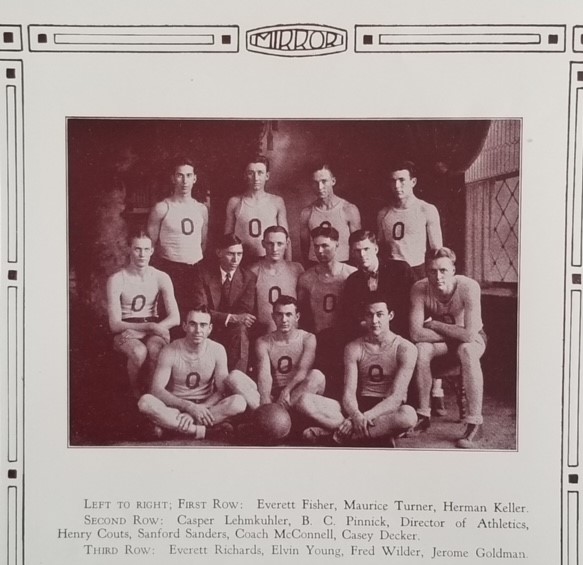
It had not been an easy journey for Oakland City teams to the sports peak of the 1920s. The school had certainly paid its dues, especially in basketball, having been an early part of the basketball scene in both the nation and in the basketball crazy state of Indiana, its struggles and adaptions to to rapidly evolving game of basketball mirroring that of other Indiana teams. Certainly too, stormy weather lay ahead—a terrible depression and two world wars, dramatic events that would bring the college and its sports programs to near annihilation. But the spunky school always fought its way back to better days, driven by the same spirit the OCC basketball teams always brought to the basketball floor.
